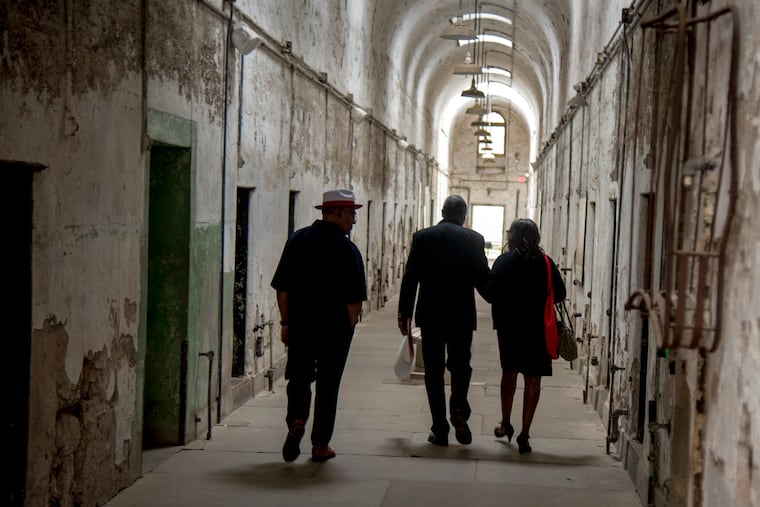The last death-row inmate at Eastern State Penitentiary returns after 50 years in prison
In April, Gov. Tom Wolf commuted Samuel Barlow’s sentence. He returned to Philadelphia just over three weeks ago — and on Wednesday evening, he walked through the open front gate of Eastern State and gazed up at the steep stone walls.

The last time that Samuel Barlow visited Eastern State Penitentiary, he arrived surrounded by six or seven guards — an escort designed, as he understood it, to make other inmates view him as dangerous.
At the time, he was just a teenager, but he and a co-defendant would become the last death-row inmates at Philadelphia’s infamous prison, built to inspire penitence in 1829 and shuttered in 1970.
“They would go to extremes to make you feel like you were on death row. It didn’t feel like it to me,” Barlow, 68, recalled. “I couldn’t envision sitting in the electric chair, frying. ... As a kid, you can’t even see to next week half the time. So you can’t see yourself getting electrocuted.”
Barlow had served as a lookout in the 1968 robbery of the Dauphin Deposit Trust Co. while his co-conspirators, Forest Tarver and Sharon Wiggins, went in, demanding thousands of dollars at gunpoint. When bank patron George Morelock approached them, they fired, wounding him fatally.
Their death sentences were overturned in 1972, after a Supreme Court ruling voided capital punishment statutes around the country. But Barlow would spend the next 48 years serving life without parole.
In April, Gov. Tom Wolf commuted Barlow’s sentence. He was released to a Community Correction Center just more than three weeks ago — and on Wednesday evening, he walked through the open front gate of Eastern State and gazed up at the steep stone walls.
“When you’re in a car and in shackles, it definitely doesn’t look like this,” he told his fiancée, Karen Lee, who was watching his face warily for signs of PTSD.
Barlow was there to be honored by the Pennsylvania Prison Society as incarcerated person of the year,” the first in a while to be available to accept the award in person. It was also a surprise reunion with Thomas McGinley, the superintendent of State Correctional Institution Coal Township, where Barlow was housed for 21 years. McGinley was being honored as correctional professional of the year for his compassionate approach, an outlook McGinley sums up this way: “If my loved ones were incarcerated, how would I want them to be treated? That’s my daily creed.”
Claire Shubik-Richards, who heads the Prison Society, said the two being honored was mere coincidence, though she added: “It is very poetic.”
The men expressed gratitude to each other.
“I believed if there was anyone deserving of commutation, it was Mr. Barlow,” McGinley said, citing his work as a mentor and community leader. Barlow was a prison imam for 40 years at various state prisons, organizing prayers and holiday feasts, consoling men in mourning, seeking to live as a spiritual inspiration. “I’ve learned from Sam, and it’s men like Sam who put me in the position I’m in today.”
Barlow, who applied for commutation 14 times over the last 40 years, believes McGinley’s recommendation was crucial.
He also had support from an unexpected source: Dauphin County District Attorney Fran Chardo, who had recently handled the resentencing of Tarver, Barlow’s co-defendant. Though Tarver is just a few months younger than Barlow, because Tarver was younger than 18 at the time of the crime, he was released last year, pursuant to a U.S. Supreme Court ruling that sentencing juveniles to mandatory life-without-parole terms is cruel and unusual.
Chardo urged the Pennsylvania Board of Pardons to allow Barlow that same opportunity. “Although he is less culpable than Tarver, he faces the more significant penalty,” Chardo wrote to the board in April 2018. He added he believed commutation was “the right thing to do.”
According to Chardo, no living relatives of Morelock could be located.
At Eastern State Wednesday, Barlow showed up in a new suit over a “Pardon Me” T-shirt he’d seen in a store window and decided was just the thing. (Anything without the letters “D.O.C.” on the back is fine with him, he acknowledged.)
Sean Kelley, director of interpretation at Eastern State, offered Barlow an impromptu tour of Cell Block 15, which contained death row — a part of the prison that was occupied for only about a decade, from 1959 until Barlow left a decade later.
“You may be the only one I’ve ever met who was on death row here," he told Barlow, “and I’ve been in this job a long time.”
Soon, Barlow was peering at the crumbling remains of the cell he had occupied for eight months on death row with an academic curiosity. There was the iron bed, attached to the wall. There, the stubs of the security fence poking from the concrete floor (the fence itself was sold for scrap in the 1970s). There, the headphone jack that piped local radio, his lone and constant friend, except for one night when the guards took away his headphones as punishment — and gave them back the next day after listening to his singing all night long.
After a while, Barlow and Lee picked their way back toward the gate and talked about how strange it was to be back.
“They don’t tear down prisons; they make them into museums,” Barlow said. “Who wants to preserve those types of memories?”